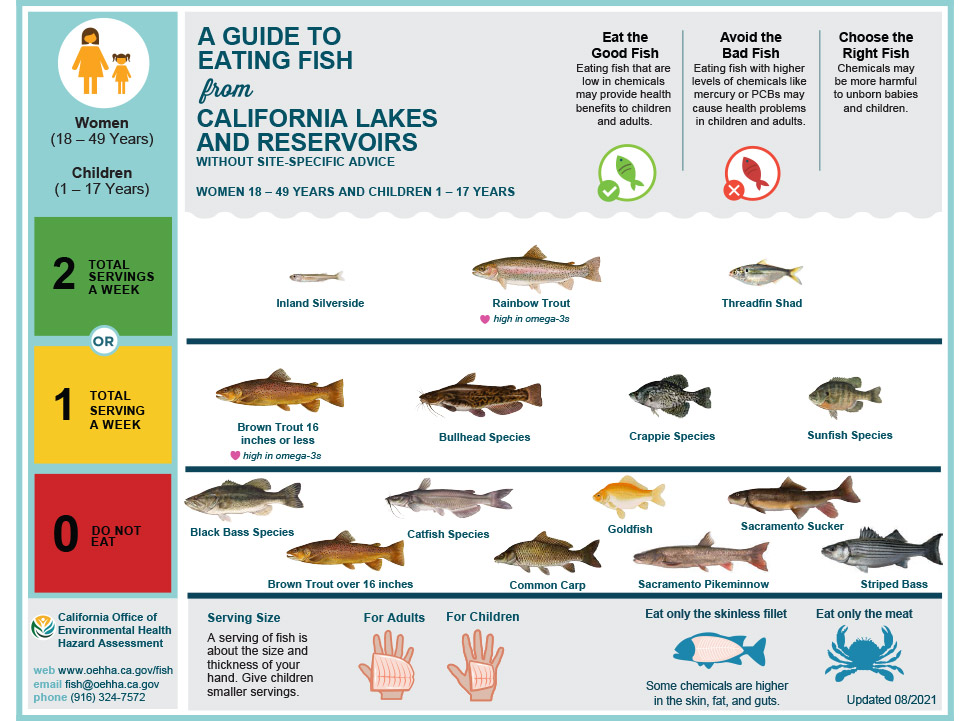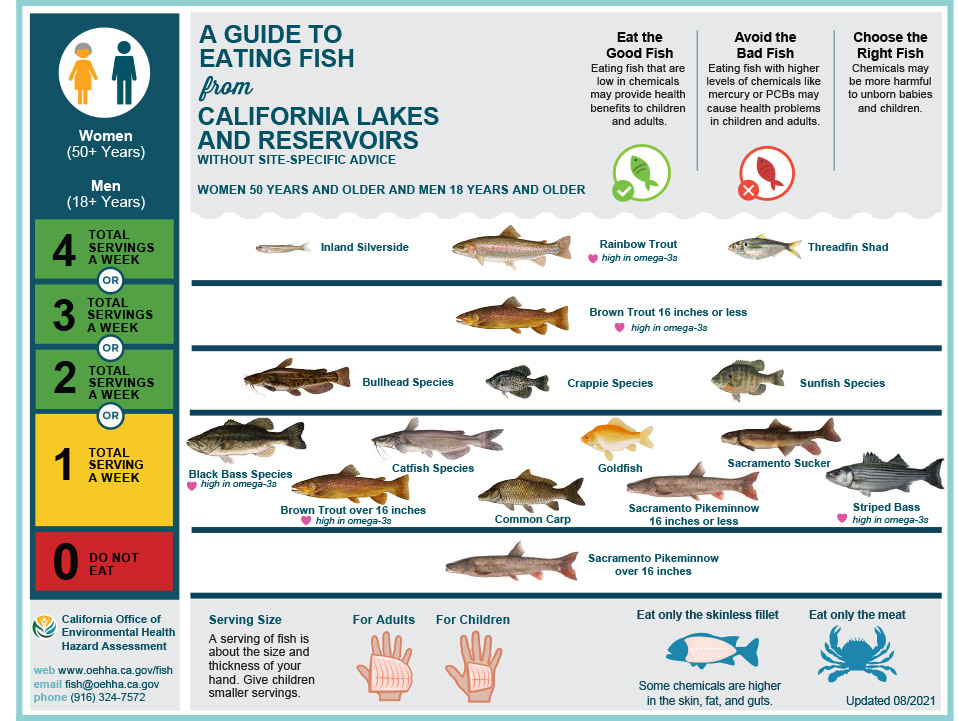New fish-consumption advisory supersedes previous one released in 2013, adds advice for seven fish species
August 18, 2021 - SACRAMENTO – The California Environmental Protection Agency’s Office of Environmental Health Hazard Assessment (OEHHA) has issued a new statewide advisory that expands and updates advice for safely consuming sport fish from lakes and reservoirs throughout the state.
The advice, issued for California lakes and reservoirs without site-specific advisories, reflects recent data on mercury and polychlorinated biphenyls (PCBs) – which accumulate in fish and can pose a health risk to people consuming them. Posters with the advice for these water bodies are available on OEHHA’s website in English and additional languages. The expanded advisory covers 14 fish species, twice the number covered in OEHHA’s original 2013 statewide advisory.
“Many fish have nutrients that may reduce the risk of heart disease and are excellent sources of protein,” said OEHHA Director Dr. Lauren Zeise. “We are thrilled to provide Californians with these updated guidelines so they can safely eat fish low in chemical contaminants and enjoy the well-known health benefits of fish consumption.”
OEHHA offers more than 100 advisories on safe fish consumption that apply to specific bodies of water in California, including lakes and reservoirs, as well as rivers, bays and coastal areas. For lakes and reservoirs where site-specific advice has not been issued, OEHHA provides this statewide advice.
The new advisory includes data collected through 2019 and is based on studies conducted at more than 300 lakes and reservoirs throughout the state. The advisory provides advice for the following species: black bass species, Brown Trout, bullhead species, catfish species, Common Carp, crappie species, Goldfish, Inland Silverside, Rainbow Trout, Sacramento Pikeminnow, Sacramento Sucker, Striped Bass, sunfish species and Threadfin Shad.
For lakes and reservoirs without a site-specific advisory, the following advice is issued:
- Women ages 18-49 and children ages 1-17 should not eat black bass species, Brown Trout over 16 inches, catfish species, Common Carp, Goldfish, Sacramento Pikeminnow, Sacramento Sucker and Striped Bass.
- Women ages 18-49 and children ages 1-17 may safely eat a maximum of two total servings per week of Inland Silverside, Rainbow Trout or Threadfin Shad, or one total serving per week of Brown Trout 16 inches or less, bullhead species, crappie species or sunfish species.
- Women ages 50 and older and men ages 18 and older should not eat Sacramento Pikeminnow over 16 inches.
- Women ages 50 and older and men ages 18 and older may safely eat a maximum of four total servings per week of Inland Silverside, Rainbow Trout or Threadfin Shad; three total servings per week of Brown Trout 16 inches or less; two total servings per week of bullhead species, crappie species or sunfish species; or one total serving per week of black bass species, Brown Trout over 16 inches, catfish species, Common Carp, Goldfish, Sacramento Pikeminnow 16 inches or less, Sacramento Sucker or Striped Bass.
One serving is an eight-ounce fish fillet, measured prior to cooking, which is roughly the size and thickness of your hand. Children should eat smaller servings. For small fish species, several individual fish may make up a single serving.
Mercury is released into the environment from mining and burning coal. It accumulates in fish in the form of methylmercury, which can damage the brain and nervous system, especially in developing children and fetuses. Because of this, OEHHA provides a separate set of recommendations specifically for children through age 17 and women of childbearing age (18-49 years).
PCBs are a group of industrial chemicals. At high levels of exposure, they can cause health problems, including cancer. Although they were banned in the United States in the late 1970s, PCBs persist in the environment from spills, leaks or improper disposal. PCBs accumulate in the skin, fat and some internal organs of fish. To reduce exposure from PCB-contaminated fish, OEHHA recommends eating only the skinless fillet (meat) portion of the fish.
Eating fish in amounts slightly greater than the advisory’s recommendations based on mercury and PCBs is not likely to cause health problems if it is done occasionally, such as eating fish caught during an annual vacation.
OEHHA’s mission is to protect and enhance the health of Californians and our state’s environment through scientific evaluations that inform, support, and guide regulatory and other actions.

Related: Statewide Advisory for Eating Fish from California's Lakes and Reservoirs without Site‑specific Advice
Source: OEHHA








